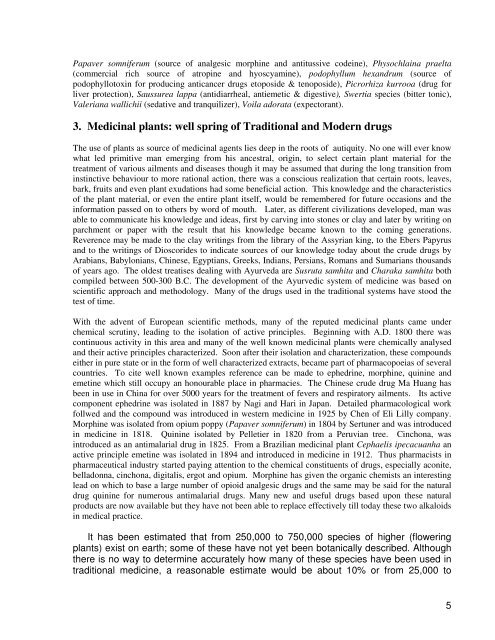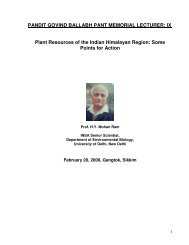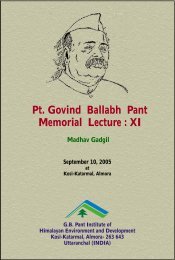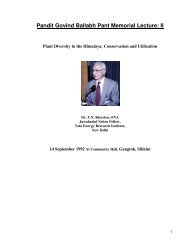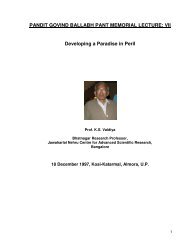Pt. Govind Ballabh Pant Memorial Lecture - XI Medicinal Plants for ...
Pt. Govind Ballabh Pant Memorial Lecture - XI Medicinal Plants for ...
Pt. Govind Ballabh Pant Memorial Lecture - XI Medicinal Plants for ...
- No tags were found...
You also want an ePaper? Increase the reach of your titles
YUMPU automatically turns print PDFs into web optimized ePapers that Google loves.
Papaver somniferum (source of analgesic morphine and antitussive codeine), Physochlaina praelta(commercial rich source of atropine and hyoscyamine), podophyllum hexandrum (source ofpodophyllotoxin <strong>for</strong> producing anticancer drugs etoposide & tenoposide), Picrorhiza kurrooa (drug <strong>for</strong>liver protection), Saussurea lappa (antidiarrheal, antiemetic & digestive), Swertia species (bitter tonic),Valeriana wallichii (sedative and tranquilizer), Voila adorata (expectorant).3. <strong>Medicinal</strong> plants: well spring of Traditional and Modern drugsThe use of plants as source of medicinal agents lies deep in the roots of autiquity. No one will ever knowwhat led primitive man emerging from his ancestral, origin, to select certain plant material <strong>for</strong> thetreatment of various ailments and diseases though it may be assumed that during the long transition frominstinctive behaviour to more rational action, there was a conscious realization that certain roots, leaves,bark, fruits and even plant exudations had some beneficial action. This knowledge and the characteristicsof the plant material, or even the entire plant itself, would be remembered <strong>for</strong> future occasions and thein<strong>for</strong>mation passed on to others by word of mouth. Later, as different civilizations developed, man wasable to communicate his knowledge and ideas, first by carving into stones or clay and later by writing onparchment or paper with the result that his knowledge became known to the coming generations.Reverence may be made to the clay writings from the library of the Assyrian king, to the Ebers Papyrusand to the writings of Dioscorides to indicate sources of our knowledge today about the crude drugs byArabians, Babylonians, Chinese, Egyptians, Greeks, Indians, Persians, Romans and Sumarians thousandsof years ago. The oldest treatises dealing with Ayurveda are Susruta samhita and Charaka samhita bothcompiled between 500-300 B.C. The development of the Ayurvedic system of medicine was based onscientific approach and methodology. Many of the drugs used in the traditional systems have stood thetest of time.With the advent of European scientific methods, many of the reputed medicinal plants came underchemical scrutiny, leading to the isolation of active principles. Beginning with A.D. 1800 there wascontinuous activity in this area and many of the well known medicinal plants were chemically analysedand their active principles characterized. Soon after their isolation and characterization, these compoundseither in pure state or in the <strong>for</strong>m of well characterized extracts, became part of pharmacopoeias of severalcountries. To cite well known examples reference can be made to ephedrine, morphine, quinine andemetine which still occupy an honourable place in pharmacies. The Chinese crude drug Ma Huang hasbeen in use in China <strong>for</strong> over 5000 years <strong>for</strong> the treatment of fevers and respiratory ailments. Its activecomponent ephedrine was isolated in 1887 by Nagi and Hari in Japan. Detailed pharmacological workfollwed and the compound was introduced in western medicine in 1925 by Chen of Eli Lilly company.Morphine was isolated from opium poppy (Papaver somniferum) in 1804 by Sertuner and was introducedin medicine in 1818. Quinine isolated by Pelletier in 1820 from a Peruvian tree. Cinchona, wasintroduced as an antimalarial drug in 1825. From a Brazilian medicinal plant Cephaelis ipecacuanha anactive principle emetine was isolated in 1894 and introduced in medicine in 1912. Thus pharmacists inpharmaceutical industry started paying attention to the chemical constituents of drugs, especially aconite,belladonna, cinchona, digitalis, ergot and opium. Morphine has given the organic chemists an interestinglead on which to base a large number of opioid analgesic drugs and the same may be said <strong>for</strong> the naturaldrug quinine <strong>for</strong> numerous antimalarial drugs. Many new and useful drugs based upon these naturalproducts are now available but they have not been able to replace effectively till today these two alkaloidsin medical practice.It has been estimated that from 250,000 to 750,000 species of higher (floweringplants) exist on earth; some of these have not yet been botanically described. Althoughthere is no way to determine accurately how many of these species have been used intraditional medicine, a reasonable estimate would be about 10% or from 25,000 to5


